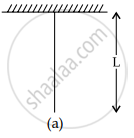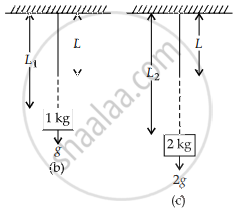Advertisements
Advertisements
Question
A wire of length L is hanging from a fixed support. The length changes to L1 and L2 when masses 1 kg and 2 kg are suspended respectively from its free end. Then the value of L is equal to :
Options
`sqrt("L"_1 "L"_2)`
`("L"_1 +"L"_2)/2`
2 L1 - L2
3L1 - 2L2
Solution
2 L1 - L2
Explanation:
Given: The final length of the wire is L1 when a mass of 1 kg is attached to it, and L2 when a load of 2 kg is attached to it.
Let the Young’s modulus of wire material be Y, Then

By Hooke’s Law of elasticity ⇒ `"F"/"A" = "Y"(Δl)/l`
Let area of cross-section of wire be A
original length of wire = L
Case - I → When 1 kg load is attached to wire change in length = L1 – L
Using Hooke’s Law
F1 = mg = 1 × g ⇒ `(1 xx"g")/"A" = "Y" (("L"_1 - "L")/"L")` ...(1)

Length of wire
(a) in normal condition
(b) When 1 kg mass is suspended
(c) When 2 kg mass is suspended
Case - II → When 2 kg load is attached to wire change in length = L2 – L
Using Hooke’s Law
F2 = mg = 2 × g
⇒ `(2 xx"g")/"A" = "Y" (("L"_2 - "L")/"L")` ...(2)
Dividing equation (1) by (2)
`1/2 = ("L"_1 - "L")/("L"_2 - "L")`
L2 - L = 2L1 - 2L
L = 2L1 - L2
